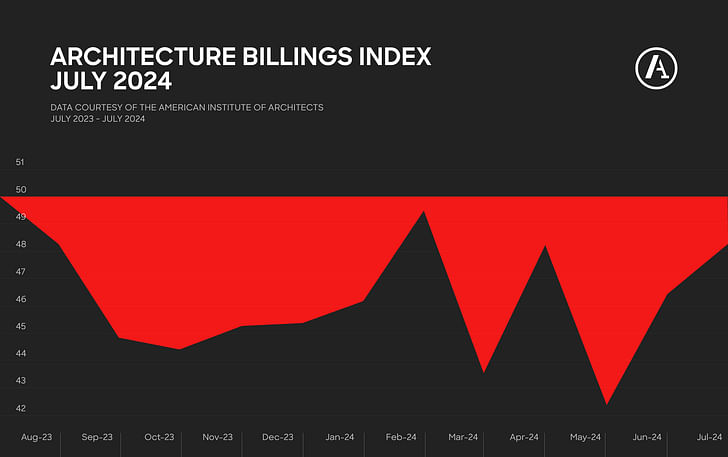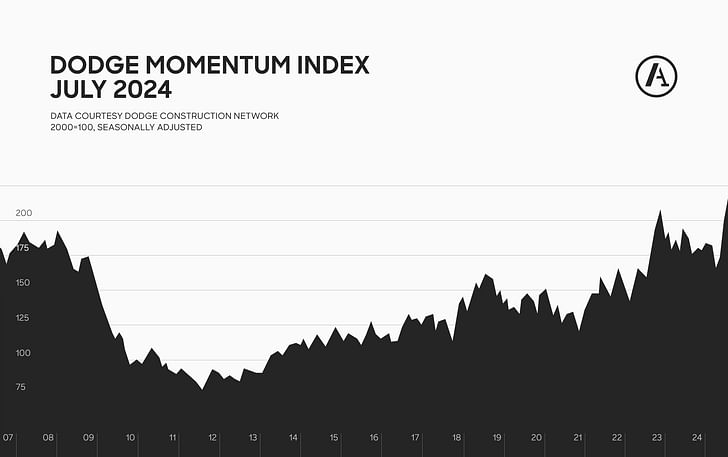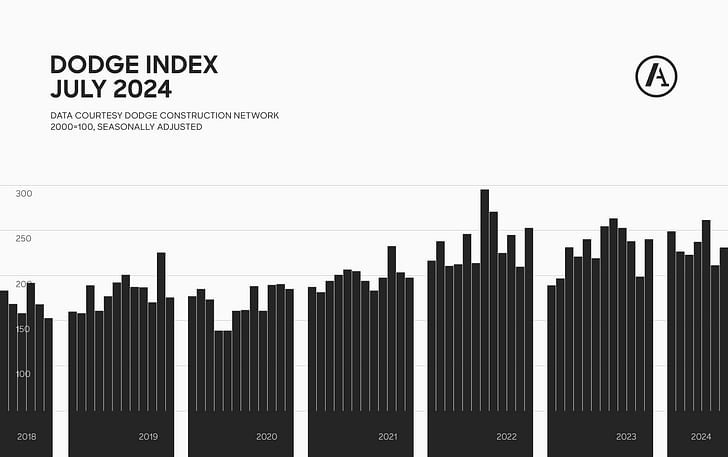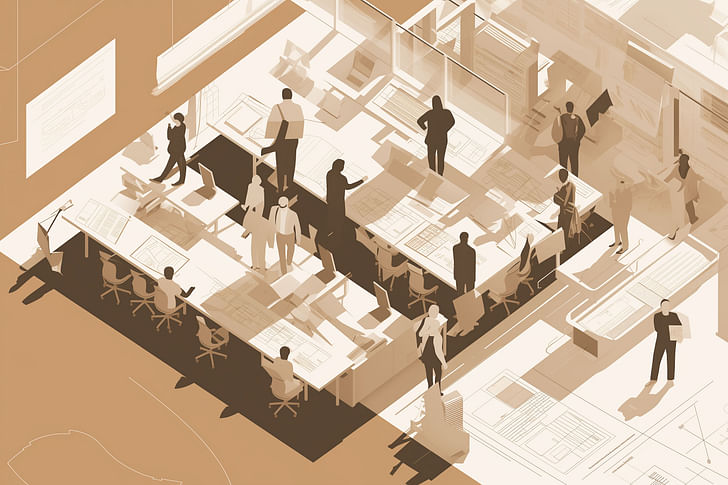

Welcome to the third installment of Archinect's new series, State of AEC. At the end of each month, we will guide you through the latest analyses, indexes, and trends on how the architecture and construction industries are performing economically.
In our previous edition of the series, we noted the almost unanimous hope expressed by commentators across the AEC industry that the U.S. Federal Reserve would announce interest rate cuts in the coming months, which may propel growth in design studios and construction sites alike. In August, those prayers were answered by the Fed's confirmation that rates would be cut from September onwards.
While the industry waits to see what impact such cuts will have, divergent trends among architecture and construction business activity continue. While billings and design contracts in architecture firms continue to decrease, construction starts rose 10%, and both apartment and hotel construction activity sits at record highs.
Read our full roundup of the month's economic and business figures below, and find out more about how the business health of the architecture profession is faring via our recently released survey results here.
Design and Planning
The latest AIA/Deltek Architecture Billings Index (ABI), covering July, found that billings are continuing to decline at a majority of firms, though not as significantly as the month before. The index score of 48.2 indicates that slightly more firms reported a decline in billings in the previous month than reported an increase. While billings declined, firms are continuing to see an increase in new inquiries, as they have done for the past year. The dollar value of new contracts signed has decreased, however, with marginally more architecture firms saying that contract values declined last month. As with billings, the rate of decline in new design contracts has slowed.
“Overall expectations are for slower growth during the next six months due to uncertainty around the election, domestic policy, geopolitical conflict, and inflation,” the AIA noted. “Regionally, home sales were generally soft, notably in the New York, Atlanta, Dallas, and San Francisco districts. In the Boston district, residential real estate activity increased, but commercial was flat due to concerns over office leasing activity. And while commercial and residential construction improved modestly in the Minneapolis district, home sales remained more mixed there too.”
In recent editions of Archinect’s State of AEC, we have noted the hope among AEC commentators that the U.S. Federal Reserve would move to cut interest rates, which have remained at a two-decade high. Last week, the Federal Reserve’s chairman, Jerome Powell, confirmed that rate cuts would start in September, having determined that inflation was on a “sustainable” path back to normal levels.

Elsewhere, July's Dodge Momentum Index, which measures the value of nonresidential building projects going into planning, saw a 7.9% increase on the previous month. The index now sits at one of its highest figures in recent years, as it did last month, and disrupts a general trend of nonresidential planning decline throughout 2024. The Dodge Momentum Index now sits 17% higher than this time last year.
“While data centers have had an outsized influence on nonresidential planning activity in recent months, more momentum is building across many other major sectors and diversifying the story behind July’s growth,” Sarah Martin, Associate Director of Forecasting at Dodge Construction Network, commented. “The potential Fed rate cut in September is becoming increasingly more likely, alongside slower inflation and weaker labor market conditions. This is likely driving owners and developers to remain optimistic about 2025 market conditions and pushing more projects into the planning queue.”

Construction
Overall, total construction starts across the United States rose 10% last month, according to Dodge Construction Network. For the 12 months ending July 2024, total construction starts are up 3% from the 12 months ending July 2023.
“Construction starts showed great promise in July,” said Richard Branch, Chief Economist of Dodge Construction Network. “However, the short-term remains questionable due to high interest rates. The Federal Reserve is likely to cut interest rates in September, which will, over time, make market conditions more conducive to moving projects forward. In the meantime, construction starts will likely remain volatile over the next few months.”
While construction activity increased last month, so did the cost of producing materials for construction, albeit marginally. Data from the U.S. Bureau of Labor Statistics showed that construction input prices increased by 0.4%, though the cost of softwood lumber production fell by 1.8%, and the cost of concrete products production showed no change.
“The lack of materials price escalation over the past 12 months is a welcome development for contractors, just 34% of whom expect their profit margins to expand over the next six months, according to ABC’s Construction Confidence Index,” said Associated Builders and Contractors Chief Economist Anirban Basu. “Ongoing input price moderation, along with the prospect of lower interest rates by the end of the third quarter, should bolster contractor sentiment in the coming months.”
Elsewhere, project delays, pauses, and abandonments in the non-residential sector experienced a sharp decline last month. ConstructConnect’s latest Project Stress Index saw a 14.2% decrease in its July metric compared to June, with disruption 6.1% down on July 2023.

Northeast
Architecture firms in the Northeast told the AIA ABI that business conditions have remained steady, with July showing neither an increase nor decrease in billings from the previous month. June was the first month in almost a year that firms reported an increase in billings.
Total construction starts in the Northeast increased last month, according to Dodge Construction Network, while U.S. Census data shows that residential unit permits granted increased significantly by 20% on last month and 15% on July 2023, seasonally adjusted.
Midwest
According to the ABI, business conditions in architecture firms in the Midwest are in decline, though the rate of decline has slowed considerably compared to the previous month. In June, the Midwest had shown the worst billing trends of the four regions, though in July it was second-best behind the Northeast.
Total construction starts in the Midwest increased last month, according to Dodge Construction Network, while U.S. Census data shows that residential unit permits granted decreased significantly by 12% on last month and 6% on July 2023, seasonally adjusted.
West
Firms in the West region have seen a continuing decline in business conditions in the ABI, though the decline rate is slower than last month. The West is nonetheless the poorest performing U.S. region for billing trends and continues to see the longest duration of decline of any region, at 22 consecutive months.
Total construction starts in the West increased last month, according to Dodge Construction Network, while U.S. Census data shows that residential unit permits granted decreased by 4% on last month and 10% on July 2023, seasonally adjusted.
South
Firms in the South region have continued a 13-month trend of reporting that business conditions have worsened in the previous month, according to the ABI, though, as with the West and Midwest, the rate of decline has slowed.
Total construction starts in the South increased last month, according to Dodge Construction Network, while U.S. Census data shows that residential unit permits granted decreased by 5% on last month and 9% on July 2023, seasonally adjusted.

Residential
According to the ABI, firms specializing in multifamily residential projects have continued to see a decline in billings. Such firms have not reported an increase in billings from the previous month since August 2022.
On the construction side, the number of residential starts fell by 8%, according to Dodge Construction Network. For the 12 months ending July 2024, residential construction starts were up 7% from the 12 months ending July 2023. Despite the decline in new construction starts on last month, apartment construction remains at a 50-year high in 2024, as Archinect reported earlier in August.
Digging deeper into the residential sector, single-family starts declined by 13%, according to Dodge, while multifamily starts rose by 3%. Over the past twelve months, single-family starts have risen 22% versus the previous twelve-month period, although multifamily starts were 8% lower.
Commercial/Industrial
Firms specializing in major non-residential sectors have reported a significant decline in billings in the previous month. According to the ABI, firms specializing in commercial/industrial projects continue to see a deterioration in billings, though not as severely as the previous month. The last time such firms reported an increase in billings in the previous month was July 2023.
Despite a decline in billings for commercial projects, the value of commercial projects currently in planning has risen by 6.8% on last month, according to the Dodge Momentum Index, with the value of such projects up 35% on this time last year.
In construction, commercial starts are up 30% on last month, attributed by Dodge Construction Network to data center and hotel activity. Meanwhile, industrial project starts rose 33% on June. For the 12 months ending in July 2024, commercial starts are down 5% more than the previous 12 months, with industrial starts being down 19%.
Corroborating Dodge’s observance of an increase in hotel activity, a new report by hospitality industry group Lodging Econometrics has found that hotel construction is at an all-time high in the U.S., as Archinect reported in August.
Institutional/Cultural
Firms specializing in institutional projects continue to report a decline in billings, according to the ABI, though the rate of decline has significantly slowed over the last three months. Such firms have nonetheless reported a decline in billings almost every month since July 2023, with the sole exception of January 2024, where billings were stagnant on the previous month.
Despite a decline in billings, there has been an increase in the value of institutional projects currently being planned. The Dodge Momentum Index reports that the value of planned institutional projects has increased 11.1%, though the value of such projects is down 14% on this time last year.
In construction, institutional starts rose 18% in July, according to Dodge Construction Network, while for the 12 months ending in July 2024, institutional starts are up 10% from the previous 12 months.

“What a sad point for the building industry to mainly rely upon the interest rates,” a commenter on last month’s State of AEC noted. “Markets and industries must invent and employ more creative, no-frills, cost-cutting ways to finance construction.”
“Who knows? That might even push the building designs to seek more inventive building methods and systems,” the commenter added. “However, that might cause different physical and cultural changes in the cities and suburbs.”
“Projects are going on hold. Projects are re-designing to lower costs. Permits are difficult to obtain,” a large firm in the South specializing in commercial and industrial projects told the AIA via their Work on the Boards survey last month.
Meanwhile, a small firm from the West specializing in residential projects told the AIA: “Higher interest rates do not seem to have slowed the pace of construction, but it has eliminated the 'tire kickers.' Most clients are now serious about their projects, and most have a significant amount of cash to fund the project, not heavily relying on financing.”
Share your own experiences of the AEC sector in the comments section below. When doing so, please tell us which U.S. Census region you are based in (Northeast/Midwest/West/South) and the size of your firm.
Finally, Archinect recently revealed the results and analysis of our survey on business conditions in the architecture industry. The results can be found here, while our analysis of the five factors behind the conditions can be found here.
Niall Patrick Walsh is an architect and journalist, living in Belfast, Ireland. He writes feature articles for Archinect and leads the Archinect In-Depth series. He is also a licensed architect in the UK and Ireland, having previously worked at BDP, one of the largest design + ...
No Comments
Block this user
Are you sure you want to block this user and hide all related comments throughout the site?
Archinect
This is your first comment on Archinect. Your comment will be visible once approved.